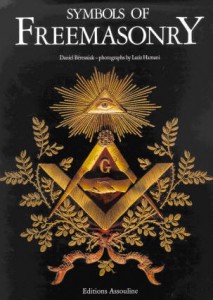Symbols of Freemasonry
by Daniel Béresniak
photographs by Laziz Hamani
ISBN: 2 84323 033 0
Published by Editions Assouline. 1997.
Distributed in the UK by Thames and Hudson
Distributed in the United States of America by St Martin’s Press
Distributed in Canada by McClelland & Stewart
 What a superb book this is, measuring 30cm X 23 cm (a little larger than A4) it is a Coffee Table book although not of the heavyweight variety as it comprises only a total of 128 pages with the text in double columns.
What a superb book this is, measuring 30cm X 23 cm (a little larger than A4) it is a Coffee Table book although not of the heavyweight variety as it comprises only a total of 128 pages with the text in double columns.
Nineteen chapters together with a Preface, Introduction and Conclusion means that the subjects is given a detailed examination without being overly academic. It is packed with facts that explain and educate at every turn. The author and translator have combined to produce a text which is philosophically stimulating (something that we Freemasons here in the UK have not always comfortable with) but at the same time describes and discusses material with which we are all familiar.
However, there is one serious error which requires to be highlighted. It is said in the Preface: ‘This work is a translation of a text written by a French Mason. Some of the content is peculiar to France and it will not be known to other Masons. Nevertheless, the basic principals described and explained are common to Freemasonry wherever it is practiced throughout the world.’
Whilst this is generally true it is not entirely accurate when applied to Scotland. Certainly the principals of Freemasonry are common throughout the world (although Scotland again has differences) but in a book attempting to describe and discuss Masonic symbolism it fails entirely to realise that Scottish Masonic symbolism, regalia and ritual is quite different from other countries. This kind of book, which projects Masonic symbolism as being common throughout the world has, unfortunately led many authors and writers to suggest that the same applies to Scottish Freemasonry.
That said this book is a delight. The photographs are superb and, in the humble opinion of this reviewer, are what makes this book so visually appealing.
PS. A Rosslyn Templar in the United States of America has informed us that a much smaller version has been published there (ISBN: 2 84323 201 5) and that the reduced size of the images means that the book simply does not have the ‘presence’ of the original.